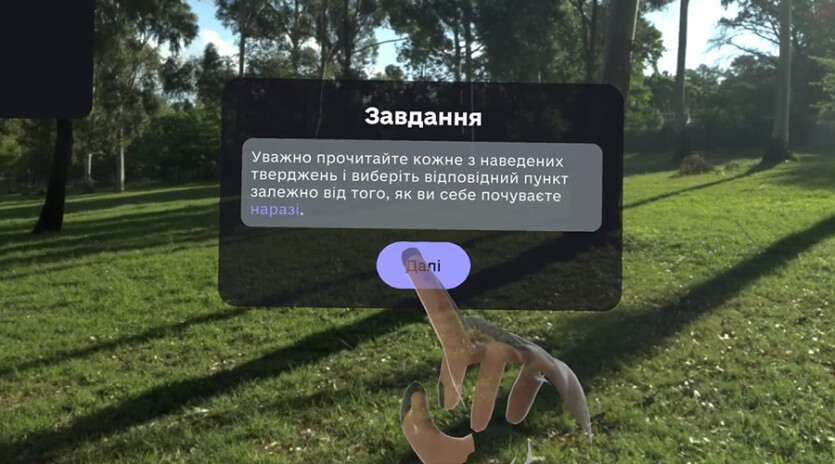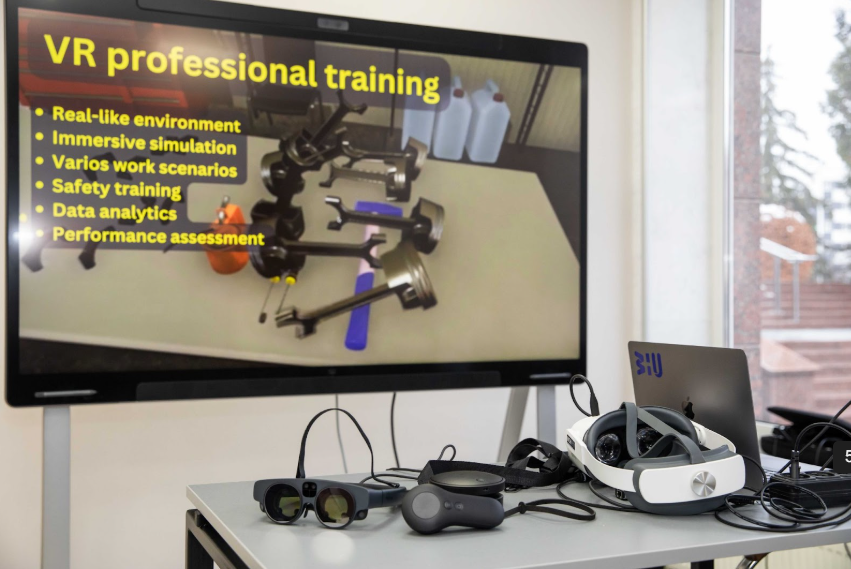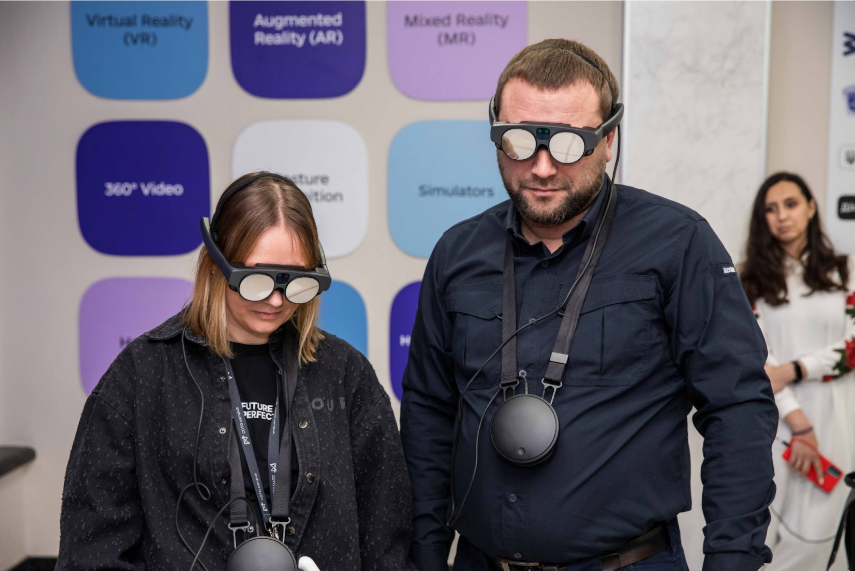Almost a year ago, the West Ukrainian National University in Ternopil opened its Immersive Multifunctional Hub. This innovative space is dedicated to implementing cutting-edge AR and VR projects across education, science, and healthcare. Initiated by the Ministry of Digital Transformation, the hub is supported by Cisco Ukraine, which provided hybrid reality equipment and technologies. Cisco also played a key role in developing the AR application Vidnova, designed to monitor physical rehabilitation progress.
The Vidnova app is being developed by a team of Ternopil scientists and medical professionals, alongside its creators, utilizing the hub’s resources.
Here’s how Vidnova operates and the additional applications of the technologies and devices available at the Immersive Multifunctional Hub.
Content
Advancements in Medical Diagnostics Using Augmented Reality
Tracking recovery progress for patients with hand injuries is particularly challenging. Even the most experienced doctors must rely on visual assessment and cannot always capture all subtle changes in movement, says Darya Fedko, CEO and founder of WE/AR Studio, a company that develops AR and VR solutions. With virtual reality, however, progress can be monitored with far greater precision, as algorithms can measure movement range with accuracy to within a single degree.
Vidnova uses art therapy, specifically drawing exercises, to track physical rehabilitation progress. The diagnostic process works as follows: The patient comes to the Immersive Multifunctional Hub, which is equipped with the necessary technology—augmented reality glasses and a camera.
Before starting, the patient wears AR glasses with the integrated patient application. Meanwhile, the doctor—who can be located anywhere with internet access—launches the therapist application on their laptop. The doctor selects a drawing template, adjusts its size, angle, and height relative to the patient’s eye level, and begins the session.”
The patient interacts with a virtual canvas displayed in front of them, while the same image is streamed to the therapist’s monitor. Both the patient and therapist can see each other in a small video window at the top of the screen, enabling seamless communication. This feature is powered by Cisco’s Webex video conferencing, which is integrated into the Vidnova application.
A camera captures and tracks every change in the angles of the patient’s wrist, elbow, and shoulder joints. The therapist sees these measurements in real time. Once the session ends, the data is saved and visualized on a graph, illustrating the patient’s progress over time. Additionally, Vidnova includes a comprehensive database of 12,000 diagnoses, allowing the therapist to select the most accurate one for the patient’s condition.
“As a physical and rehabilitation medicine specialist, it’s essential for me to track how the range of motion changes during the rehabilitation process and compare it to the healthy limb’s data,” explains Darya Popovych, head of the Department of Physical Therapy, Occupational Therapy, and Physical Education at Ternopil National Medical University, who is also involved in the development of the app.
Vidnova includes this feature: when the therapist hovers over a recorded measurement, a window appears showing the normal range for comparison.
How Vidnova Assesses Emotional Well-being
The use of art therapy for diagnosis was a deliberate choice. Darya Popovych explains: “It’s an evidence-backed approach that lets us observe how the range of motion shifts while performing tasks.” Besides its diagnostic value, art therapy also aids in regaining limb mobility since the patient’s arms are actively engaged in drawing. Additionally, the doctor emphasizes the importance of tracking not only physical progress but also the patient’s psychological changes. To achieve this, Vidnova incorporates a test from the Anima platform, which evaluates the emotional and psychological state through eye tracking.
The screening algorithm is based on attention bias measurement—it analyzes what the person focuses on and how they direct their attention. The doctor, or the patient themselves if the doctor is remote, activates the Anima test on a laptop. The patient then wears augmented reality glasses, and different pairs of images appear in front of their eyes. The images alternate between pairs of contrasting stimuli: negative ones like injuries, snakes, and spiders that represent potential threats, and positive ones like food, joyful moments, and children with ice cream.



“We evaluate what stimulus the person focuses on, how long they gaze at it, how quickly they shift attention between images, whether they look away, and how often they blink,” explains Roman Havrysh, CEO and co-founder of Anima. “Frequent blinking indicates disinterest, while rare blinking suggests the opposite.”
With these parameters, the platform can assess how the nervous system responds to threats, how it detaches from negative stimuli, and whether it can experience pleasure, among other factors.
Eye tracking is considered one of the most advanced methods of using AR in digital diagnostics. Roman Havrysh highlights that it enables a shift from subjective judgment to objective analysis based on data. The test results are interpreted by a doctor.
“Anima enables us to monitor the patient’s condition at the beginning of therapy and how it evolves – whether it improves or if further consultation with a specialist is needed,” explains Tetyana Huseva, Associate Professor at the Department of Psychiatry, Addiction, and Medical Psychology at Ternopil National Medical University.
The Anima test results will be stored in the patient’s record in Vidnova, allowing the doctor to track the overall progress over time.
The Team Behind the Project
The Vidnova project was developed by a group of educators, researchers, and doctors from Ternopil, who recognized the potential of using innovative technologies and the hub’s equipment in a project focused on physical rehabilitation. Cisco supported the project by providing Webex hybrid reality technology and funding.
“As the number of individuals affected by Russian aggression continues to rise, we at Cisco are committed to supporting Ukrainians by offering digital and technical resources, as well as implementing projects that foster digital transformation in education and healthcare. Vidnova is one of these initiatives,” says Volodymyr Orlov, leader of the Country Digital Acceleration (CDA) program in Ukraine.
The CDA program is active in 50 countries, helping governments implement digital initiatives. Ukraine joined the program last summer after Cisco signed a memorandum of cooperation with the Ministry of Digital Transformation.

They brought in a company with more than nine years of experience in developing augmented and virtual reality applications to create the software. During this time, WE/AR Studio has completed more than 150 projects.
Vidnova is currently in its final testing stage. Once launched, the app will be used directly in the rehabilitation process. Initially, it will support patients in Ternopil, although therapists can be located anywhere. There are no limitations on scaling the project, as the required equipment—AR glasses and a camera—can be installed in any physical rehabilitation office across Ukraine.
What capabilities does the ‘Immersive Hub’ offer?
The hub’s equipment extends beyond AR headsets and Webex collaboration technology. Cisco has provided tablets, a Cisco Board Pro 75 interactive display, and Cisco Meraki infrastructure to ensure reliable internet connectivity and networking. These resources enable students and researchers to visualize data, simulate processes, and model scenarios across diverse fields, from healthcare to economics. Moreover, the equipment facilitates the development and testing of system prototypes within a virtual environment.

“Faculty members at the West Ukrainian National University are developing educational programs within the hub that integrate immersive technologies, explains Nazar Ivanytskyi, head of the Digital Transformation Department at ZUNU and coordinator of the hub’s operations. “Researchers and graduate students from our university, in collaboration with colleagues from the I.Ya. Horbachevsky Ternopil National Medical University, are working on scientific projects, one of which is a simulation of thyroid surgeries in augmented reality.
The hub also serves as a launch site for a pilot project by the Ministry of Education and Science—a support center for students with special educational needs. Groups from the Educational and Scientific Center for Social-Psychological Support and Resilience come here to undergo Anima testing.

“Digital accessibility stands as a key priority for the Ministry of Digital Transformation. We aim not just to develop online services, but to ensure everyone has equal access to technology. To support the inclusion and socialization of various groups in society, we launched the country’s first immersive multifunctional hub,” says Valeria Ionan, Deputy Minister of Digital Transformation for European Integration.
The opening of the hub is part of the National Strategy to create an accessible space by 2030, initiated by First Lady Olena Zelenska. It also demonstrates the implementation of Ukraine’s Global Innovation Vision—WINWIN. This vision includes the development of MedTech, EdTech, and immersive technologies such as AR and VR. MedTech will contribute to faster recovery times, making medical services more efficient and accessible for all.
“Vidnova represents a project that both implements modern MedTech solutions and trains healthcare professionals in VR technology use. Overall, the hub serves as a model for how this strategy is applied within local communities. It enables local specialists to leverage cutting-edge technologies for solving real-world challenges,” says Volodymyr Orlov. “We hope that Ternopil’s example will encourage leaders from other regions to implement similar projects in their communities.”
Spelling error report
The following text will be sent to our editors: